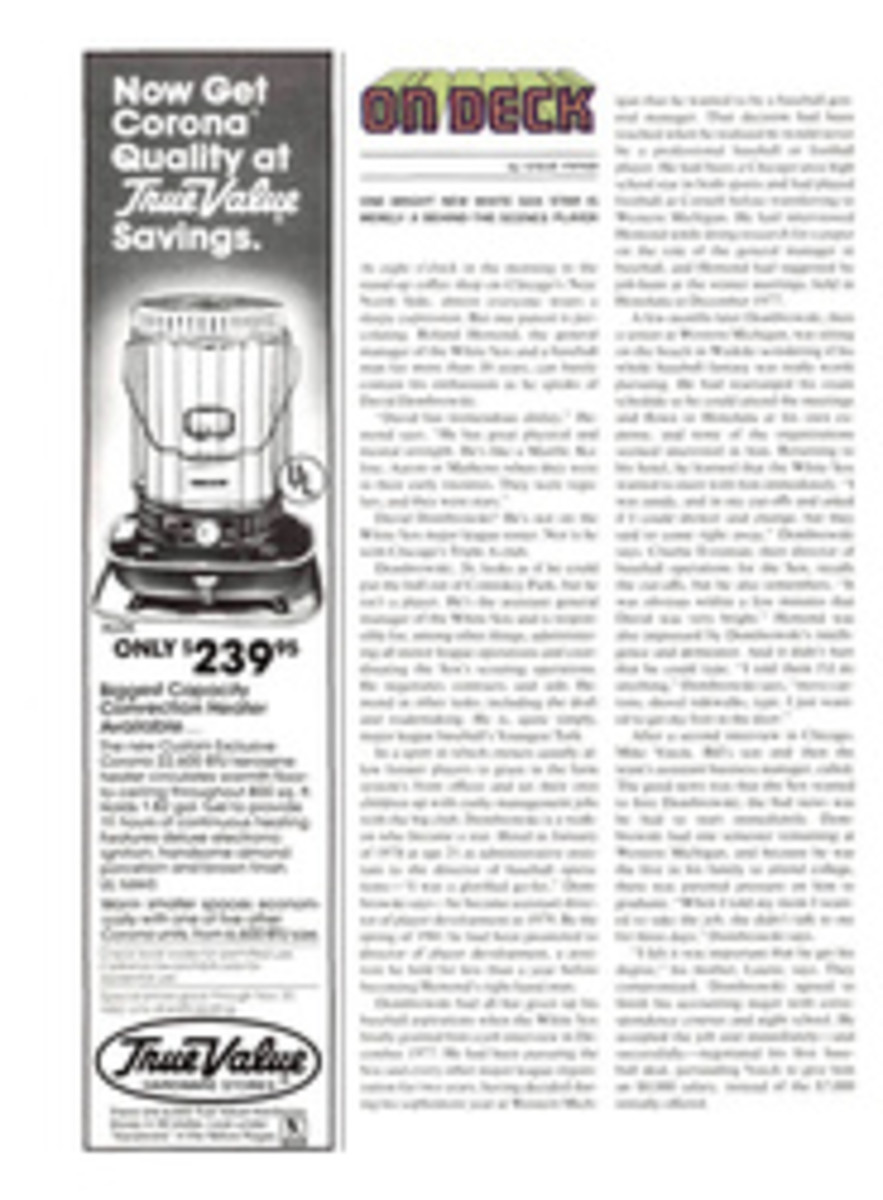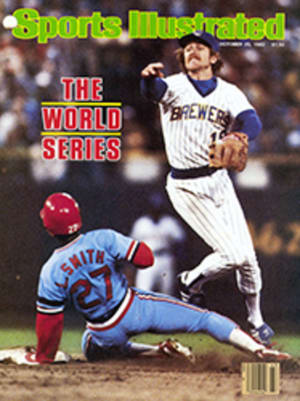
Huck Finn on a 175-mph raft
When Al Unser Jr. and his pregnant wife, Shelley, arrived in Las Vegas last month for the Coors Can-Am race at Caesars Palace, they headed straight for the casino to try their luck. Shelley put a silver dollar in the first slot machine in her path. She pulled the handle, peered expectantly at the spinning symbols and stood back as—jackpot!—150 silver dollars showered into the tray. Little Al, as he's called by those who don't know his dad well enough to call him Junior, was impressed. "Is that all you have to do?" he asked. "I'm gonna go get me some of them dollars."
Them dollars have been pouring in, sure enough, but not only from the slots. Unser, 20, is too young to play legally in Nevada's casinos (Shelley is 23), and a few cups of quarters gathered on the sly were the best he could do. No matter. Little Al, son of Baby Al, the three-time Indy winner and youngest of the racing Unser brothers, is making his fortune in the freewheeling world of Can-Am racing. That's the Sports Car Club of America's nine-race series featuring bellowing five-liter cars that look as if they have been swiped off the back lot of the latest Star Wars movie. They can hit 180 mph on a road racing circuit with any sort of decent straightaway. But it's not a series that gets much publicity—many of the drivers are less concerned with making a splash and moving on to bigger things than with driving, as one of them put it, "the ultimate road racing car for fun." So it seems a strange place to find Little Al Unser, a young man intent on racing in the Indianapolis 500.
Nevertheless, the Can-Am season opened on a rainy May day in Gainesville, Ga., with Unser driving a revamped hand-me-down Galles GR-2 Chevy in which his father had gained a Can-Am triumph, at Laguna Seca, Calif., two years earlier. When the leader, two-time Can-Am champion Patrick Tambay, was bumped and skidded off the slick Road Atlanta track, Unser, running second, inherited the victory, becoming the youngest driver ever to win a Can-Am race. Unser went on to win three more and come in second twice. Then two weeks ago at Laguna Seca, he won the season finale by 78.720 seconds over Al Holbert. That gave him the Can-Am point championship plus earnings of $149,000 for the season. Not much when you consider that his new car, a Galles GR-3 that first arrived in July, cost $140,000. But it's still a good wage for a 20-year-old seasonal laborer. More important, Unser has earned universal respect for his smooth and aggressive driving style.
Well, almost universal. "Whenever we go to a race," says Shelley, "we rent a car. He likes to drive me around the track, at about 85 or 90, so I'm sliding all over the place. Everybody's been saying the baby's gonna come out sideways—'cause that's the way Al drives those rental cars—with lots of dents in its head."
It's not hard to believe. Al Sr. and little Al's Uncle Bobby, who have won five Indy 500s between them, are willing to bang heads with anyone. And Little Al is fiercely proud of his family and its tradition. Less a renegade than his uncle, perhaps, but more independent than his father, he is set on carrying the Unser name forward a generation or two, dents and all. And so he has seized the chance to learn from his dad and uncle, drawing from their divergent styles his own winning combination. In fact, of the generation of racing sons just coming of age—including Mario Andretti's son Michael, 20, Geoff Brabham, 30 (son of two-time world champion Jack), and his own cousin, Bobby Unser Jr., 26—Little Al is the best bet to challenge or, as he would no doubt prefer to put it, take a place alongside the big daddies of race driving.
He is already the crowd's favorite son. He's the spitting image of his father, with the same defiant eyes, winning smile and round cheeks that bulge as if stuffed with three weeks' worth of chewing tobacco. Not a man plagued by uncertainty, he speaks his piece deliberately, with a Southwestern twang. "I've never wanted to be anything but a race car driver," he'll say.
"Junior sure reminds you of Huckleberry Finn. And I guess the world is looking for that," says driver-turned-race-car-manufacturer Dan Gurney, who must have been looking for the same thing himself. Gurney and Rick Galles, a car dealer, plan to pool their resources and campaign a new Gurney-built Eagle car on the CART circuit next year—with Little Al behind the wheel.
So there it is. Not yet 21, Unser has realized his deepest ambition—to move up to champ cars, as racers call the Indy machines. Already he's had the thrill of running with the big boys, having made his champ car debut in the AIRCAL 500 in Riverside last month. In a show of cool persistence, he drove a March to a fifth-place finish behind CART champion Rick Mears. Gurney was pleased. "Junior's mature," he said. "He drives something like Mears, you know. He has the sense of how to pace his car to victory." Because he's a veteran of only one CART race, Unser will officially begin his rookie champ-car season next spring. He'll be the junior driver on the championship trail, which suits him fine. "I've always been the youngest," he says.
And always precocious. Things began moving for Little Al when he was seven. His father gave him a minibike, a bewildering gift coming from a man who a few months earlier had broken his ankle moto-crossing with his car owner, Parnelli Jones, on the golf course out back of Gasoline Alley at the Indianapolis Motor Speedway. A likely pole sitter, Al missed the 500 that year. By the age of nine Al Jr. was racing Go-Karts with great success in the Albuquerque area, which serves as home base for the Unser clan. Al Jr. recalls that at about this time his parents "did their deal," fighting out a divorce in court and the headlines of the Albuquerque newspapers. Al Jr. spent most of the next four years with his mother, who resumed her maiden name, Wanda Pachta. He says, "A lot of parents say, 'How can your mom let you race?' She gets a little bit nervous. But she married a race driver and she knows what the risk is. She loves racing. She never really wanted me to do anything else."
At 16, Little Al, who had decided to return to his father's home, ran his first professional race. It was a sprint car event at Speedway Park in Albuquerque, where Bobby, now 48, and Al Sr., 43, began their careers. "I wouldn't give up that experience for anything," Little Al says. "Racing sprint cars on the dirt taught me to be really aggressive, to hustle the race car and run wheel to wheel." It's also where he met Shelley.
In 1981, impatient to get on the road to Indianapolis, Unser left the dirt circuit and accepted an offer from Galles to drive Super Vee, a series featuring open-wheeled, Volkswagen-powered cars and considered the top training ground for Indy-type racing. He won four of nine races, edged veteran Pete Halsmer for the season points title and was named SCCA Rookie of the Year. Flushed with success, the Galles team wanted to jump directly into the CART fray.
Alarmed, Al Unser Sr. persuaded his son, and the Galles team, to run Can-Am instead. "He thought it'd help me get used to the horsepower and the top speed," says Little Al. "It was good for me that I ran this series. I think the first year in Indy cars really matters a lot. If you do good the car owners will see you and you'll get the good rides the next year. You know if you don't do it the first year, then you never will."
All along, Al Sr. has steered his son right. He pushed him into staying in high school and earning the diploma he himself never got. He convinced Little Al that he would always do better on a one-driver team, citing his own experience in the early '70s with the Vels-PJ group—with Andretti and two-time Indy car points champion Joe Leonard as teammates—and his subsequent decision to race, alone, for Jim Hall. (The problem is, says Al Jr., "who gets the good stuff?")
"I'd give anything for the boy to follow in my footsteps and be better than me," Al Sr. has said, but he has gone about blazing the trail more gently than his brother, who obviously had the same in mind for his son Bobby Jr. "My uncle's very demanding, maybe too demanding," says Al Jr. "He came from the '40s and '50s. It took a lot of work in those days to become a race driver. You had to do it on your own. With my dad, I didn't have to build my own race car. I've always had a car owner and a mechanic. But my uncle wanted Bobby Jr. to know how to do the whole thing on his own. Bobby Jr. wanted to race very badly. His will was strong, and it's strong now, but it kind of got chopped in all these little pieces. You really have to have a strong backbone with my uncle.... My dad did a lot of things different. He would tell me if I made a mistake, and how to correct it. But my dad has never raised his voice at me about my driving."
Not that Al Jr. hasn't learned from Uncle Bobby. He says, "The one person I like to sit down and talk to is my uncle, 'cause he knows so much about chassis. He's a super driver, but what he really likes is getting a chassis working to perfection. There's so many things you can do to cure a car's problems. It's picking the one thing that cures it without hurting anything else. I like to concentrate on doing that." And as an aid to concentration, Little Al's gone so far as to name his dog Chassis.
As for a name for the kid—Shelley is due sometime this month—the Unsers are still talking. Male names only. Al looks like the winner. Albert the Third? No, Albert Richard. Why not Al III? "Because I don't like thirds," says Al. "Don't like seconds, either. I consider myself a junior."
TWO PHOTOS
Unser, 20 but looking younger, will have an Indy ride and his Can-Am car in '83.
PHOTO
Al and Shelley won't call the baby Al III.

